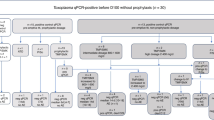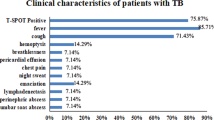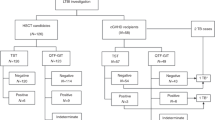Abstract
We performed a single-centre retrospective study to evaluate the effectiveness of Toxoplasma gondii prevention strategies after allogeneic stem-cell transplantation. The charts of 138 allogeneic stem-cell recipients over a 4-year period were reviewed. Forty-nine percent of patients were not receiving optimal trimethoprim–sulfamethoxazole (TMP–SMZ) prophylaxis at day +30, mainly due to persistent cytopenia. Six months after transplantation, the rate of toxoplasmosis reactivation was 11.6%, including nine cases of Toxoplasma infection and seven cases of Toxoplasma disease. Fifty-six percent of cases of reactivation occurred before day +30. Thirty-eight percent occurred in patients receiving atovaquone prophylaxis. In 57% of patients presenting with Toxoplasma disease, signs of disease were present at first evidence of Toxoplasma DNA in peripheral blood samples. This study illustrates the limitations inherent to currently used toxoplasmosis prevention strategies and argues for the use of a combined prophylactic and preemptive approach. After performing the initial study, we limited the use of atovaquone in favour of TMP–SMZ when possible, and implemented an early prevention strategy consisting of the introduction of prophylaxis starting on day of engraftment. Over the following 16 months, 88.9% of eligible Toxoplasma-seropositive patients were receiving TMP–SMZ at day +30, and the rate of early Toxoplasma reactivation was 1.5%.
This is a preview of subscription content, access via your institution
Access options
Subscribe to this journal
Receive 12 print issues and online access
$259.00 per year
only $21.58 per issue
Buy this article
- Purchase on Springer Link
- Instant access to full article PDF
Prices may be subject to local taxes which are calculated during checkout
Similar content being viewed by others
References
Martino R, Maertens J, Bretagne S, Rovira M, Deconinck E, Ullmann AJ. et al. Toxoplasmosis after hematopoietic stem cell transplantation. Clin Infect Dis. 2000;31:1188–95.
Gajurel K, Dhakal R, Montoya JG. Toxoplasma prophylaxis in haematopoietic cell transplant recipients: a review of the literature and recommendations. Curr Opin Infect Dis. 2015;28:283–92.
Martino R, Bretagne S, Einsele H, Maertens J, Ullmann AJ, Parody R. et al. Early detection of Toxoplasma infection by molecular monitoring of Toxoplasma gondii in peripheral blood samples after allogeneic stem cell transplantation. Clin Infect Dis. 2005;40:67–78.
Meers S, Lagrou K, Theunissen K, Dierickx D, Delforge M, Devos T, et al. Myeloablative conditioning predisposes patients for Toxoplasma gondii reactivation after allogeneic stem cell transplantation. Clin Infect Dis. 2010;50:1127–34.
Robert-Gangneux F, Meroni V, Dupont D, Botterel F, Garcia JMA, Brenier-Pinchart M-P, et al. Toxoplasmosis in transplant recipients, Europe, 2010–2014. Emerg Infect Dis 2018;24:1497–504.
Derouin F, Pelloux H. ESCMID Study Group on Clinical Parasitology. Prevention of toxoplasmosis in transplant patients. Clin Microbiol Infect. 2008;14:1089–101.
Center for International Blood and Marrow Transplant Research (CIBMTR), National Marrow Donor Program (NMDP), European Blood and Marrow Transplant Group (EBMT), American Society of Blood and Marrow Transplantation (ASBMT), Canadian Blood and Marrow Transplant Group (CBMTG), Infectious Disease Society of America (IDSA) et al. Guidelines for preventing infectious complications among hematopoietic cell transplant recipients: a global perspective. Bone Marrow Transplant. 2009;44:453–558.
Hughes WT, LaFon SW, Scott JD, Masur H. Adverse events associated with trimethoprim-sulfamethoxazole and atovaquone during the treatment of AIDS-related Pneumocystis carinii pneumonia. J Infect Dis. 1995;171:1295–301.
Robert-Gangneux F, Sterkers Y, Yera H, Accoceberry I, Menotti J, Cassaing S. et al. Molecular diagnosis of toxoplasmosis in immunocompromised patients: a 3-year multicenter retrospective study. J Clin Microbiol. 2015;53:1677–84.
Katlama C, Mouthon B, Gourdon D, Lapierre D, Rousseau F. Atovaquone as long-term suppressive therapy for toxoplasmic encephalitis in patients with AIDS and multiple drug intolerance. Atovaquone Expand Access Group Aids. 1996;10:1107–12.
Megged O, Shalit I, Yaniv I, Stein J, Fisher S, Levy I. Breakthrough cerebral toxoplasmosis in a patient receiving atovaquone prophylaxis after a hematopoietic stem cell transplantation. Pedia Transpl. 2008;12:902–5.
Falloon J, Sargent S, Piscitelli SC, Bechtel C, LaFon SW, Sadler B. et al. Atovaquone suspension in HIV-infected volunteers: pharmacokinetics, pharmacodynamics, and TMP-SMX interaction study. Pharmacotherapy. 1999;19:1050–6.
Tomonari A, Takahashi S, Ooi J, Tsukada N, Konuma T, Kato S. et al. No occurrence of Pneumocystis jiroveci (carinii) pneumonia in 120 adults undergoing myeloablative unrelated cord blood transplantation. Transpl Infect Dis. 2008;10:303–7.
Conrad A, Le Maréchal M, Dupont D, Ducastelle-Leprêtre S, Balsat M, Labussière-Wallet H, et al. A matched case-control study of toxoplasmosis after allogeneic haematopoietic stem cell transplantation: still a devastating complication. Clin Microbiol Infect. 2016;22:636–41.
Fontanet A, Chalandon Y, Roosnek E, Mohty B, Passweg JR. Cotrimoxazole myelotoxicity in hematopoietic SCT recipients: time for reappraisal. Bone Marrow Transpl. 2011;46:1272–3.
Author information
Authors and Affiliations
Corresponding author
Ethics declarations
Conflict of interest
The authors declare that they have no conflict of interest.
Additional information
Publisher’s note: Springer Nature remains neutral with regard to jurisdictional claims in published maps and institutional affiliations.
Rights and permissions
About this article
Cite this article
Paccoud, O., Guitard, J., Labopin, M. et al. Features of Toxoplasma gondii reactivation after allogeneic hematopoietic stem-cell transplantation in a high seroprevalence setting. Bone Marrow Transplant 55, 93–99 (2020). https://doi.org/10.1038/s41409-019-0641-y
Received:
Revised:
Accepted:
Published:
Issue Date:
DOI: https://doi.org/10.1038/s41409-019-0641-y
This article is cited by
-
Outcomes of toxoplasmosis after allogeneic hematopoietic stem cell transplantation and the role of antimicrobial prophylaxis
Bone Marrow Transplantation (2024)
-
Reduced post-transplant cyclophosphamide dose with antithymocyte globulin in peripheral blood stem cell haploidentical transplantation
Bone Marrow Transplantation (2023)
-
A 10-year retrospective analysis of Toxoplasma gondii qPCR screening in allogeneic hematopoietic stem cell transplantation recipients
Bone Marrow Transplantation (2023)



